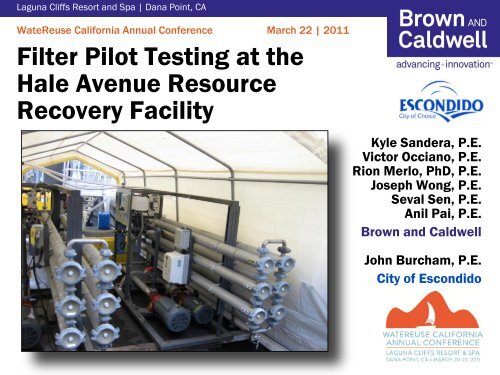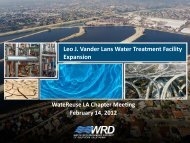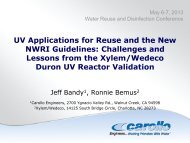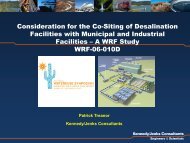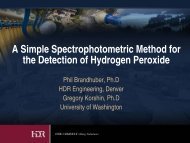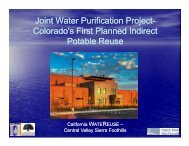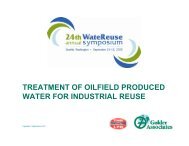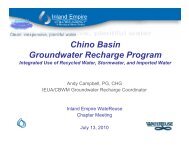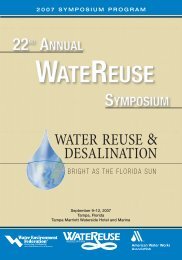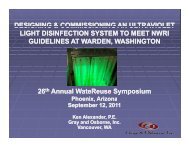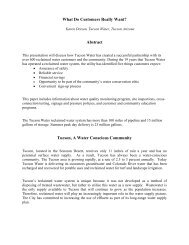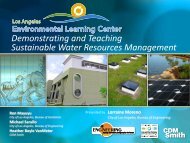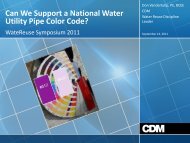Filter Pilot Testing at the Hale Avenue Resource Recovery Facility
Filter Pilot Testing at the Hale Avenue Resource Recovery Facility
Filter Pilot Testing at the Hale Avenue Resource Recovery Facility
You also want an ePaper? Increase the reach of your titles
YUMPU automatically turns print PDFs into web optimized ePapers that Google loves.
Laguna Cliffs Resort and Spa | Dana Point, CA<br />
W<strong>at</strong>eReuse California Annual Conference March 22 | 2011<br />
<strong>Filter</strong> <strong>Pilot</strong> <strong>Testing</strong> <strong>at</strong> <strong>the</strong><br />
<strong>Hale</strong> <strong>Avenue</strong> <strong>Resource</strong><br />
<strong>Recovery</strong> <strong>Facility</strong><br />
Kyle Sandera, P.E.<br />
Victor Occiano, P.E.<br />
Rion Merlo, PhD, P.E.<br />
Joseph Wong, P.E.<br />
Seval Sen, P.E.<br />
Anil Pai, P.E.<br />
Brown and Caldwell<br />
John Burcham, P.E.<br />
City of Escondido
Present<strong>at</strong>ion Outline<br />
HARRF Overview<br />
Project Objectives<br />
Process Description<br />
Sampling Plan<br />
Test Results<br />
Conclusions and Recommend<strong>at</strong>ions
HARRF Overview<br />
3
<strong>Hale</strong> <strong>Avenue</strong> <strong>Resource</strong> <strong>Recovery</strong> <strong>Facility</strong><br />
(HARRF)<br />
18 mgd conventional activ<strong>at</strong>ed sludge plant<br />
5 mgd recycled w<strong>at</strong>er production using DynaSand filter<br />
12 mgd secondary effluent disposed to ocean via land and<br />
ocean outfalls<br />
Outfalls are approaching capacity limits<br />
HARRF also has permit for intermittent wet-we<strong>at</strong>her<br />
discharges of tre<strong>at</strong>ed effluent to nearby Escondido Creek
Project Objectives<br />
5
Project Objectives<br />
To evalu<strong>at</strong>e <strong>the</strong> performance of Aqua-Aerobics Cloth-<br />
Media <strong>Filter</strong> (CMF) in achieving California Title 22<br />
requirements<br />
To evalu<strong>at</strong>e CMF performance under high solids loading<br />
conditions<br />
To evalu<strong>at</strong>e <strong>the</strong> ability for Ultrafiltr<strong>at</strong>ion-Reverse Osmosis<br />
(UF/RO) to reduce <strong>the</strong> nitrogen and phosphorus content<br />
To determine <strong>the</strong> UF/RO performance under three<br />
different feed w<strong>at</strong>er sources
Process Description<br />
7
Process Flow Diagram<br />
INFLUENT<br />
PRIMARY<br />
CLARIFIER<br />
WASTE<br />
SLUDGE<br />
AIR<br />
AERATION TANK<br />
RETURN ACTIVATED SLUDGE<br />
CMF<br />
BACKWASH<br />
SECONDARY<br />
CLARIFIER<br />
WASTE<br />
SLUDGE<br />
UF<br />
BACKWASH<br />
<strong>Pilot</strong> Process<br />
SECONDARY<br />
EFFLUENT<br />
PUMP STATION<br />
FILTRATION<br />
OUTFALL<br />
RO<br />
CONCENTRATE<br />
DISINFECTION<br />
PERMEATE<br />
REUSE
Cloth Media <strong>Filter</strong>
Ultrafilter
Reverse Osmosis<br />
3 Modules/vessel<br />
6 Vessels active<br />
Inactive vessels<br />
but flow still<br />
coming through
Test Area Setup
Sampling Plan<br />
13
Sampling Plan<br />
CLOTH-MEDIA FILTER ULTRAFILTER REVERSE OSMOSIS<br />
COMPOSITES GRABS<br />
TSS<br />
TKN<br />
TSS<br />
Oil & Grease<br />
Turbidity<br />
NO3, NO2 Turbidity Settleable Solids<br />
TDS<br />
Conductivity<br />
CBOD<br />
Anions (Cl, SO4, F)<br />
Title 22 metals + c<strong>at</strong>ions<br />
NH3 MBAS<br />
Color<br />
Cyanide<br />
Silica<br />
TDS<br />
Conductivity<br />
Total Coliform<br />
Fecal Coliform<br />
Acute Toxicity<br />
Pharmaceuticals<br />
Anti-Bacterials<br />
Steroids and Hormones<br />
TP<br />
Barium<br />
Enterococci<br />
NDMA<br />
Ortho P<br />
Strontium<br />
E. Coli<br />
AlkylPhenols
Test Results<br />
15
Comparison of Liquid Streams<br />
CMF Filtr<strong>at</strong>e UF Perme<strong>at</strong>e RO Perme<strong>at</strong>e<br />
RO Concentr<strong>at</strong>e
CMF Influent (Secondary Effluent) Particle Size<br />
Distribution<br />
Particle Size Channels (micron)<br />
>30<br />
20 to 30<br />
15 to 20<br />
10 to 15<br />
6 to 10<br />
2 to 6<br />
0% 10% 20% 30% 40% 50% 60% 70% 80% 90% 100%<br />
Percent Particle Size Distribution
Results – CMF Removal Efficiency<br />
Particle s Size Channels (micron)<br />
>30<br />
20 to 30<br />
15 to 20<br />
10 to 15<br />
6 to 10<br />
2 to 6<br />
0% 10% 20% 30% 40% 50% 60% 70% 80% 90% 100%<br />
Bench Scale Results<br />
Avg <strong>Pilot</strong> Results<br />
Reduction R<strong>at</strong>e
CMF Performance – <strong>Pilot</strong> Readings<br />
16.00<br />
14.00<br />
12.00<br />
10.00<br />
8.00<br />
6.00<br />
4.00<br />
2.00<br />
0.00<br />
3.25 gpm/sq.ft. 3.52 gpm/sq.ft. 3.90 gpm/sq.ft.<br />
High Solids Load<br />
<strong>Testing</strong><br />
Chemical<br />
Addition<br />
<strong>Testing</strong><br />
8-Mar-10 15-Mar-10 22-Mar-10 29-Mar-10 5-Apr-10 12-Apr-10<br />
Influent Turbidity (NTU) Effluent Turbidity (NTU) Backwash as % of Total Influent Flow
Turbidity (NTU)<br />
CMF vs DynaSand – 24-hr Composites<br />
5.0<br />
4.0<br />
3.0<br />
2.0<br />
1.0<br />
0.0<br />
1-Mar-10 8-Mar-10 15-Mar-10 22-Mar-10 29-Mar-10 5-Apr-10 12-Apr-10<br />
Secondary Effluent-24-hr Comp.<br />
CMF Effluent-24-hr Comp.<br />
D<strong>at</strong>e Dynasand Influent- Daily Average<br />
Dynasand Effluent- Daily Average
Turbidity (NTU)<br />
Ultrafilter Performance<br />
5.0<br />
4.5<br />
4.0<br />
3.5<br />
3.0<br />
2.5<br />
2.0<br />
1.5<br />
1.0<br />
0.5<br />
0.0<br />
Phase 1 Phase 2 Phase 3<br />
3-Mar-10 13-Mar-10 23-Mar-10 2-Apr-10 12-Apr-10 22-Apr-10 2-May-10 12-May-10 22-May-10 1-Jun-10 11-Jun-10 21-Jun-10<br />
D<strong>at</strong>e<br />
Secondary Eff. Comp. Turb. 24-Hr Comp. UF Eff. Turbidity CMF Effluent-24 hr Composite
UF <strong>Recovery</strong> Clean
UF <strong>Recovery</strong> Clean
Phosphorus Concentr<strong>at</strong>ion (mg/L as P)<br />
UF/RO – Phosphorus Removal<br />
3.0<br />
2.5<br />
2.0<br />
1.5<br />
1.0<br />
0.5<br />
0.0<br />
Phase 1 Phase 2 Phase 3<br />
3/3 3/11 3/19 3/27 4/4 4/12 4/20 4/28 5/6 5/14 5/22 5/30 6/7<br />
UF Influent Total P UF Influent Ortho P<br />
D<strong>at</strong>e<br />
RO Perme<strong>at</strong>e Total P RO Perme<strong>at</strong>e Ortho P
UF/RO – Nitrogen Removal<br />
INF – 19.72 mg/L EFF – 1.88 mg/L<br />
90% Removal
RO Perme<strong>at</strong>e Nitrogen Speci<strong>at</strong>ion<br />
% by Weight Contribution of Nitrogenous Species to Total<br />
Nitrogen<br />
120%<br />
100%<br />
80%<br />
60%<br />
40%<br />
20%<br />
0%<br />
10%<br />
45%<br />
11%<br />
34%<br />
28%<br />
32%<br />
13%<br />
28%<br />
UF Influent TN RO Perme<strong>at</strong>e TN<br />
NO3 NO2 NH3 Org N
Concentr<strong>at</strong>ion (ug/L)<br />
Concentr<strong>at</strong>ions of Metals in RO Perme<strong>at</strong>e<br />
1000<br />
100<br />
10<br />
1<br />
0.1<br />
0.01<br />
Aluminum<br />
Antimony<br />
Arsenic<br />
Barium<br />
Beryllium<br />
Boron<br />
Cadmium<br />
Calcium<br />
Chromium<br />
Cobalt<br />
Copper<br />
Iron<br />
Lead<br />
3/21/2010 4/18/2010 5/26/2010<br />
Magnesium<br />
Manganese<br />
Mercury (by cold …<br />
Molybdenum<br />
Nickel<br />
Potassium<br />
Selenium<br />
Silver<br />
Sodium<br />
Thallium<br />
Vanadium<br />
Zinc
Concentr<strong>at</strong>ion (ng/L)<br />
Concentr<strong>at</strong>ions of CECs in Liquid Streams<br />
10000<br />
1000<br />
100<br />
10<br />
1<br />
CMF Filtr<strong>at</strong>e UF Perme<strong>at</strong>e RO Perme<strong>at</strong>e
Conclusions and<br />
Recommend<strong>at</strong>ions<br />
29
Conclusions<br />
Cloth-Media Filtr<strong>at</strong>ion<br />
Low SRT produces high fraction of fine particles<br />
Cloth-media filter can meet Title 22 standards<br />
CMF effluent turbidity was below 2 NTU > 99% of <strong>the</strong> time<br />
DynaSand (with chemical addition) outperformed cloth-media<br />
which did not have chemical addition<br />
Membrane Filtr<strong>at</strong>ion<br />
UF consistently produced effluent with turbidity below 0.5 NTU<br />
UF/RO phosphorus removal was excellent and can meet 0.1 mg/L<br />
concentr<strong>at</strong>ion potentially required for live-stream discharge<br />
UF/RO nitrogen removal averaged 90%; however, <strong>the</strong> required<br />
effluent concentr<strong>at</strong>ion of 1.0 mg/L cannot be met with this process<br />
given <strong>the</strong> influent TN concentr<strong>at</strong>ion
Recommend<strong>at</strong>ions<br />
Options to consider depending on City’s goals:<br />
Option 1<br />
Install a skid-mounted CMF unit to increase recycled w<strong>at</strong>er<br />
production in <strong>the</strong> near-term and conduct extended testing<br />
Option 2<br />
Modify upstream tre<strong>at</strong>ment process to fully nitrify and denitrify<br />
effluent for TN reduction prior to UF/RO process<br />
Option 3<br />
Install post tre<strong>at</strong>ment system downstream of UF/RO if<br />
upstream process changes are not possible
Acknowledgements<br />
The authors would like to acknowledge <strong>the</strong> City of Escondido’s<br />
Oper<strong>at</strong>ions and Maintenance, and Labor<strong>at</strong>ory staff who<br />
contributed to <strong>the</strong> success of <strong>the</strong> study.<br />
Dennis Sperino<br />
James Larzalere<br />
John del Fante<br />
Vasana Vip<strong>at</strong>ap<strong>at</strong><br />
Pete Klein
Questions?<br />
33


